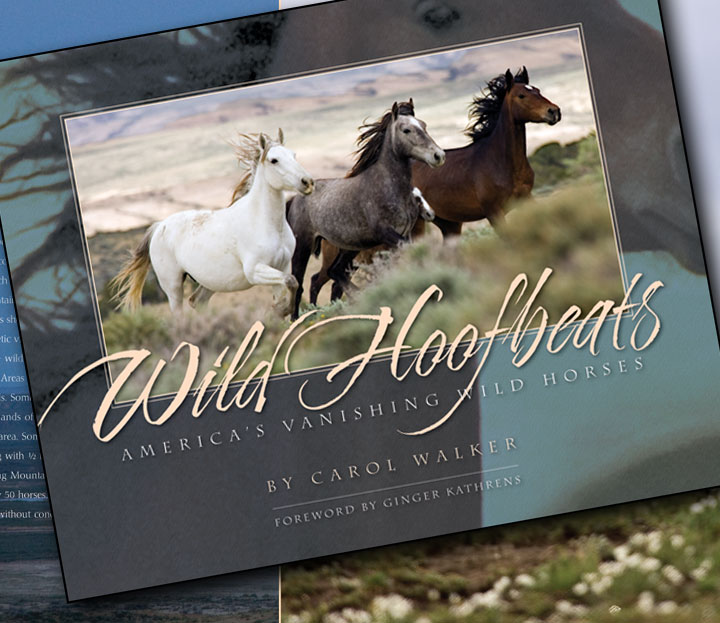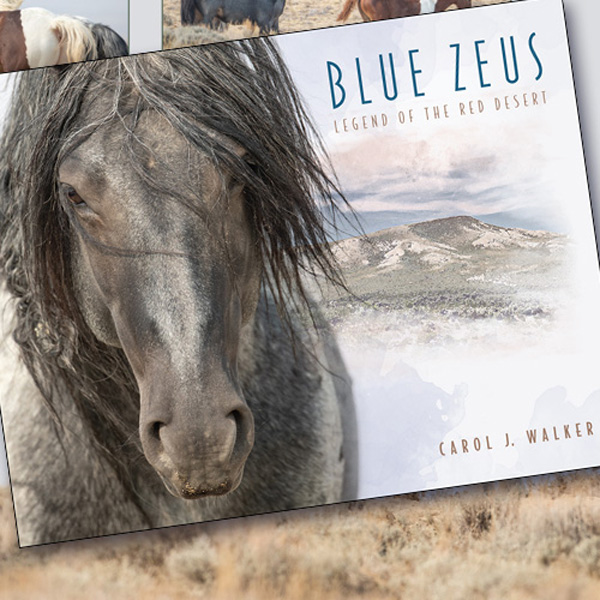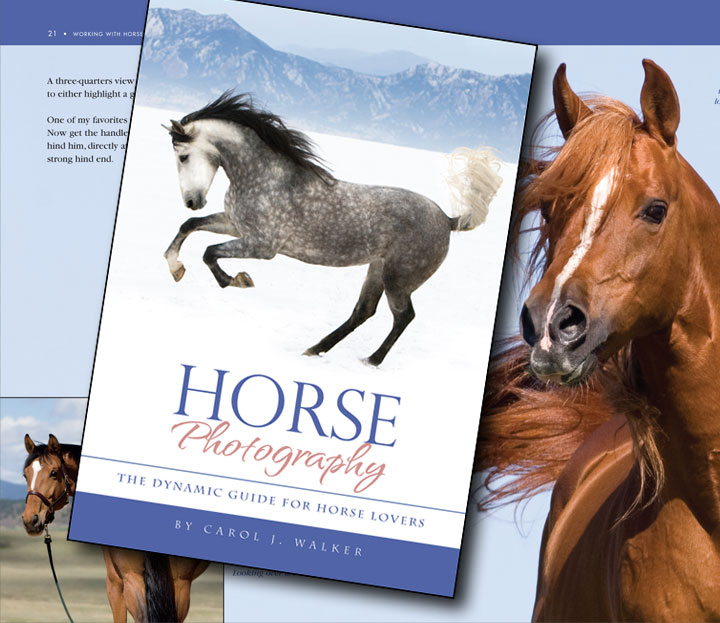
Horse Photography
January 24, 2018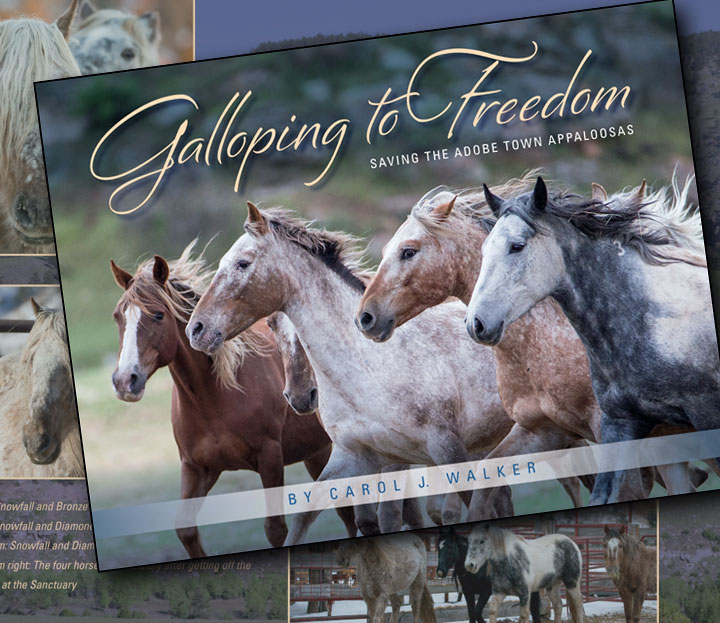
Galloping to Freedom
January 25, 2018Wild Hoofbeats
$29.95
An emblem of the American West and once numbering in the millions, the wild horse is considered by some today as a resource to be exploited or a pest to be eliminated. Now the wild horse is on the verge of being removed entirely from our nation’s public lands. Wild Hoofbeats takes us deep into “Adobe Town” in Wyoming’s Red Desert and one of the largest remaining wild herds in America. In passionate prose, but above all in stunning photographs that are both intimate and grand, Carol Walker convinces us to take the future of these elegant, exceptional animals to heart.
“Dust boils up off the prairie. In a land that seems empty of all but sagebrush, wisps of grass, dirt and sun…moving shapes begin to take form: white blazes, flashing eyes, manes flying and tails waving, the occasional sharp hoof. There is sound too, a gradually growing dull thunder that vibrates the ground like an enduring earthquake. Soon dust, shapes, and sounds resolve themselves into running horses—a huge number of running horses.”
– from the introduction to Wild Hoofbeats
An emblem of the American West and once numbering in the millions, the wild horse is considered by some today as a resource to be exploited or a pest to be eliminated. Now the wild horse is on the verge of being removed entirely from our nation’s public lands. Wild Hoofbeats takes us deep into “Adobe Town” in Wyoming’s Red Desert and one of the largest remaining wild herds in America. In passionate prose, but above all in stunning photographs that are both intimate and grand, Carol Walker convinces us to take the future of these elegant, exceptional animals to heart.
What others are saying about Wild Hoofbeats:
“Carol Walker’s love of wild horses is evident. The collection of masterful photographs in Wild Hoofbeats, along with the insightful and personal account of her experiences, gives us a poignant glimpse into the secret and oftentimes tragic wold of America’a wild horses. Through her sincere commitment and dedication, Carol is helping to bridge a very important gap between two worlds.
–Tony Stromberg, author of Spirit Horses
“There is nothing more important than preserving what is left of our open spaces,
natural resources and wildlife species. It is long overdue that America’s wild horses are
recognized as a native wildlife species and claim their rightful home on the American
landscape. The dedicated and passionate work of Carol Walker gives an overdue and
much needed voice to these magnificent and ancient creatures.”
– Neda DeMayo
Founder, Return To Freedom, American Wild Horse Sanctuary
“This book is an excellent read both for the novice and expert wild horse enthusiast. Ms. Walker captures the complex wild horse issue completely from wild horse behaviors to BLM’s mismanagement and simplifies it for all readers. This book is a wake up call to American citizens to take action to stop the massive removals of an already declining wild horse population in our country. The wild horses of our country represent our American heritage as symbols of freedom and the last living icons of the old West but beyond the symbolism, they are truly a magnificent wildlife species. America’s wild horses are stronger, healthier, extremely intelligent and there is almost no inbreeding in the herds leaving these animals as the “extraordinary horse” compared to their domestic counterparts. Their ability to survive at all odds should be heralded and not destroyed. ”
– Karen A. Sussman
President, International Society for the Protection of Mustangs and Burros
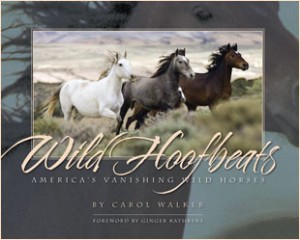
From Painted Hills Publishing
July 28, 2008
FOR IMMEDIATE RELEASE
Wild Hoofbeats Gallops Into Every Horse Lover’s Heart
Wild horses: bold, elusive, independent. Above all, free. Or are they? Most of us consider wild horses honored emblems of our Western spirit, but some see them as a resource to exploit or even a pest to eliminate. Which are they? For Carol Walker, the photographer and author of Wild Hoofbeats, the answer begins not in abstract argument over symbols and statistics, but with the horses themselves. In images that move fleetly from the pages straight into our hearts, Walker brings to brilliant life the horses of the Adobe Town herd in Wyoming’s Red Desert, and we gain a priceless perspective on these graceful, courageous animals.
Walker gathered these dynamic images over years spent observing (sometimes at a distance, often within a mere stride or two) the bands of the Adobe Town herd. She emerged from her experience with a sense of personal acquaintance with the horses, a deep respect for their social allegiances and intelligence—and a heart fully engaged by their plight. As art, the photographs are elegant. As documentary, they are evocative. In every respect, they are indelibly memorable.
But Walker doesn’t rest with photographs. In quiet, spare prose Walker invites us to journey with her as she meets the horses in the initial blur of mass impression, then band by band, and eventually, individual by individual. We come to recognize each stallion and note as the seasons pass the new battle scars, the special attention each gives to a favorite mare. We understand which mare is tender, which is a disciplinarian with her baby. And of course, we grow attached to the youngsters, first as curious foals, finally as adults venturing into perilous independence. In the final chapters, Walker takes us on the roundup done by the BLM to control herd population, and we hold our breath. Which ones return home to their family bands, and which are separated forever? Ultimately, we are as invested in these horses as if they are our own.
So, travel with Carol Walker through Wild Hoofbeats, savor every painterly image and every poignant story, but beware: you cannot venture through this book and emerge unchanged.
Carol Walker’s passion for photography started at an early age, with animals as her favorite subjects. She studied literature and photography at Smith College, and continued after graduation to study portraiture and nature photography. For the past 28 years, she has photographed wildlife the world over; since becoming aware of the precarious situation of the wild horses, she has dedicated herself to educating people about them through her photographs and her stories.
In her business, Living Images by Carol Walker, Walker specializes in horse photography, illuminating the relationship between horses and their people, as well showcasing horses’ ineffable beauty in stunning images of them at liberty. Her commercial work includes on-site horse portraiture, catalog covers, and calendars; her fine art prints are available at www.LivingImagesCJW.com as well as in several galleries on the Front Range of Colorado.
Order Wild Hoofbeats now! The perfect Christmas gifts for the horse lovers in your life—including yourself.
AHP Newsgroup:
April 13 , 2009
FOR IMMEDIATE RELEASE
Carol Walker, Author of Wild Hoofbeats to Present at Upcoming EPNet Workshop
Carol Walker, author of the book Wild Hoofbeats, will lead a seminar during the upcoming Equine Photographers Network Workshop in Craig, Colorado that begins by telling the story of the wild horses in this country and the challenges that currently face them. She will also share tips and suggestions on photographing horses in the wild, as well as techniques that work for capturing the most captivating images. In the second part of the seminar, Carol will describe her journey in self-publishing with her book, and will give you ideas, suggestions and resources for you own self-publishing projects.
Carol will also be signing copies of her book at Downtown Books in Craig, Colorado on Thursday, May 7 from 4-6PM.
More information on the upcoming workshop and the book may be found at http://events.equinephotographers.net/col09/index.htm
Contact:
Carien Schippers
info@equinephotographers.org
607 865 5215
Review by ForeWord Reviews
America’s Vanishing Wild Horses
Carol Walker
Painted Hills Publishing
Softcover $29.95 (160pp)
978-0-981793641
Horses are seldom seen as wild creatures, only as domestic companions to be bridled and saddled
for our own use. The natural life of this majestic animal holds a fascination for equine lovers
who desire to see horses thrive in their native habitat rather than conform to human needs in a
corral. A comfortable, even posh, enclosure in a climate-controlled environment with a
veterinarian-approved diet cannot compare to the elation a stallion experiences when running
freely across open terrain. Horses bond with one another, establishing a riveting society with
rules and standards that include displays of affection, territorial boundaries, and competition. The
gestures of a mare tending to her foal in an open, fertile landscape, or the expression of a stallion
staring in stoic outrage behind a chain-link fence communicate the presence of free, intelligent,
and emotional creatures.
Few have observed what award-winning photographer Carol Walker has captured in Wild
Hoofbeats: America’s Vanishing Wild Horses. In a striking presentation, Walker chronicles the
day-to-day activities of a herd in Adobe Town, Wyoming, until a routine roundup reduces its
population. At the Hughes Ranch in Oklahoma and the US Bureau of Land Management (BLM)
facility in Rock Springs, Wyoming, Walker focuses her camera on the defeated faces of those
confined in holding corrals.
The roundups are a BLM ritual, aimed at managing wild herd populations by relocating the
horses. However, as Walker points out, animals are often removed from areas that are not yet
approaching overpopulation status; in fact, all wild horses have been removed from 102 of the
original 303 designated areas for wild horses.
Not only are the roundups unnecessary, they are dangerous. During these herd-control
procedures, the horses are subjected to tremendous stress. Stallions are castrated, and some do
not survive their painful ordeal. Equine families with offspring are chased at high speed with
helicopters for as many as fifteen grueling miles. Even though care is taken not to separate
lactating mares from their foals, wet mares are frequently extracted anyway. Then dependent
foals must be bottle-fed on foster ranches, and bonded families are split apart.
Rather than preserving and protecting what remains of America’s wild hoofbeats, current policy,
according to Walker, is cruel and irresponsible, overly-responsive to cattle ranching interests,
and not supportive of protecting genetically-viable herds.
Carol Walker is a gifted photographer with several decades of experience. Her passion for
capturing wildlife on film began when she was a child, and after formal training, she’s traveled
throughout the world with her camera, immersing herself in nature and portraiture work,
including commercial work for the equine industry. Today she has dedicated herself to
photographing wild horses along with educating concerned citizens about their plight on public
lands in the West. She’s pursued herds in Montana, Wyoming, and Colorado, learning about
these precious animals by observation.
In this book, Walker introduces particular horses and herds with text and photographs, and
follows some individual horses through the roundup and subsequent relocation. She has also
done her policy homework, explaining the BLM current and proposed policies, and including the
perspectives of other government and university studies.
A part of our natural heritage, these living, breathing, roaming landmarks deserve better
treatment than the “politics” of current land management allow. Wild Hoofbeats is a profound
and beautiful tribute to the wild heartbeats that infuse the American West with vitality.
(December 2008) Julia Ann Charpentier
Review Date: May 2010
Heartland Reviews
“This lovely coffee table book illustrates the plight of wild horse herds throughout Western America and focusing on the Southwestern corner of Wyoming. There is excellent material for everyone interested in the subject. First are the gorgeous pictures which portray the wide variety of wild horses. Although there are the expected telephoto pictures, what is far more impressive are the close-up shots, This author/photographer is an extraordinarily brave lady. She actually got out and walked amongst the herds, sitting down on the ground in front of them, even when concerned herd stallions came charging up to a stop five feet in front of her. They could have easily trampled her to death. She has to have nerves of steel and a sense of equine knowledge and trust far greater than many
This is further illustrated by her straight forward language she uses to tell the plight of these horses as cattlemen and sheepherders attempt to run the wild animals off the range. Ms Walker explains in detail the day to day lives within the herds, how each is protected by a herd stallion who has to take on all challengers to his breeding rights. She also explains the roles played by various horses within the herds and how nature cuts back the possibility of too much inbreeding. She fairly portrays the various parties involved in the issue of wild equines and their various agendas. The combination of beautiful pictures and cogent writing makes this coffee table book a fascinating read. We rated it four hearts.
Bob Spear
Heartland Reviews
Apogee Photo Magazine
September Photo Book Reviews: By Elizabeth Powis
One of the largest wild horse herds in the United States, and the largest in the state of Wyoming, is the subject of Carol Walker’s book. She spends four years documenting the lives of seven bands (families) before they were eventually rounded up and removed from the area. Walker has a passion for the future of these wild horses that are decreasing in numbers in the US. She uses amazing photographs and her own experiences to tell their story. Walker talks about the land mismanagement and suggestions for future protection from large wild horse removals, which continue to threaten an already declining population. We are encouraged, as US citizens, to stand up and make a difference for these true symbols of the American west heritage and for the sake of the animals themselves. These creatures should have the right to roam free with their families without being disturbed.
Text: A+
Layout: A+
Photography: A+
User: All Photographers and Non-Photographers
NEW Review by ForeWord- Click Here
NEW Review by The US Review of Books- Click Here
Review by American Herds – Click Here
Review by Nature Picture Library- Click Here
Review by Midwest Book Review – Click Here
Review by Feast – Click Here
Review by Reins Magazine – Click Here
Review by Equestrian Network Magazine – Click Here
Review by the Gillette News Record – Click Here
Nautilus Silver Award-Winner in the Animal/Nature Category
Read the full Nautilus Awards page here.
USA Book News Awards
Award-Winner in the Photography:Nature category and Award-Winning Finalist in the Best Interior Design category of the National Best Books 2009 Awards, sponsored by USA Book News
2008 Pinnacle Book Award for Photography
Read about the Pinnacle Book Award
Independant Publisher Book Awards: Silver Medal for West Mountain Region: Best Non-Fiction
Eric Hoffer Awards: Honorable Mention in the Art Category
National Indie Excellence Awards: Finalist in the Art Category
Benjamin Franklin Awards: Finalist in the Animals/Pets Category
The 2010 Cloud Foundation Calendar:
www.CalendarAssociation.org Wildlife Photography Merit Award
Check back frequently to see about Carol’s Book Signings and Events
Book signings:
March 26, 10 – 3 Mustang Day at Jax Mecantile Company in Lafayette, CO with a visiting mustang
http://www.jaxmercantile.com/calendar.php
May 14, 12 – 5 at Barbed Wire Books in Longmont, CO event with 37 other local authors
http://www.barbedwirebooks.net/
SAVE ON BOOK PACKAGE DEALS!
Galloping to Freedom + Wild Hoofbeats 3rd Edition + Horse Photography 2nd Edition
Only $75.88 + s&h (Normally $94.85)
Galloping to Freedom + Wild Hoofbeats 3rd Edition
Only $59.42 + s&h (Normally $69.90)
Galloping to Freedom + Horse Photography 2nd Edition
Only $54.42 + s&h (Normally $64.95)
Wild Hoofbeats 3rd Edition & Horse Photography 2nd Edition
$46.67 US + s&h (SAVE 15%)

